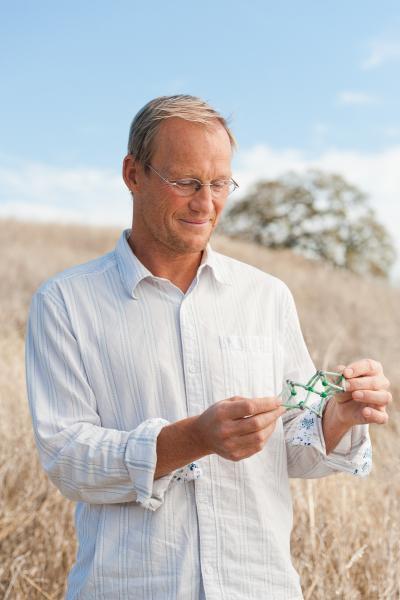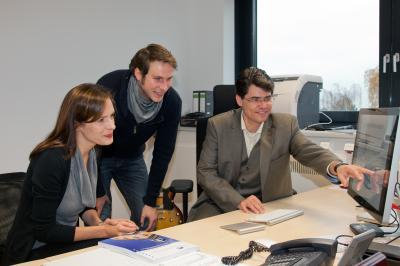Menlo Park, Calif., Nov. 17, 2011 — If we could make plant food from nitrogen the way nature does, we'd have a much greener method for manufacturing fertilizer – a process that requires such high temperatures and pressures that it consumes about 1.5 percent of the world's energy.
Now scientists working at the Department of Energy's SLAC National Accelerator Laboratory have taken an important step towards understanding how nature performs this trick, by identifying a key atom that researchers had sought for more than a decade.
The atom lies at the heart of an enzyme called nitrogenase, which plays a critical role in converting nitrogen in the air into a form that living things can use. Scientists have long sought to determine the structure of this enzyme; among other things, they hope to eventually reverse-engineer it and mimic nature's gentle version of the reaction.
"The fascination with this enzyme is the fact that it enables this reaction to take place at room temperature and atmospheric pressure," said chemist Serena DeBeer of Cornell University and the Max Planck Institute for Bioinorganic Chemistry, who led the team that performed crucial experiments at SLAC. So hot was the race to identify the mystery atom that it ended in a photo finish: in the Nov. 18 issue of Science, two independent teams, using different approaches, identify the atom as carbon.

SLAC National Accelerator Laboratory's Uwe Bergmann holds a model of a critical cluster of atoms inside the nitrogenase enzyme where atmospheric nitrogen is converted into a form that living things can use. Bergmann developed the technique that was used to identify a key atom in the cluster as carbon. He is on a team that describes the work in a Nov. 18 Science paper.
(Photo Credit: Matt Beardsley, SLAC)
It had eluded scientists because of its sequestered location inside a cluster of metal atoms. The key in the team's research was a technique called X-ray emission spectroscopy, or XES, which co-author Uwe Bergmann of SLAC had developed over the past decade.
The researchers needed a trick to find the one important carbon inside the metal cluster. They used an intense beam of X-rays from the Stanford Synchrotron Radiation Lightsource to knock the innermost electrons out of iron atoms in the cluster. Normally other electrons from iron would fill this hole; but there was a tiny chance, much less than one in a thousand, that the hole would be filled by an electron belonging to a neighboring atom, and thus emit X-rays characteristic of the neighbor's identity. It was this subtle feature in the X-ray emission spectrum that revealed that a carbon atom, rather than a nitrogen or oxygen, was bound to the iron atoms in the cluster.
"This was a simple but important question and we were able to give a straightforward answer," Bergmann said. "I think this will have a big impact not only on the understanding of nitrogenase but on the use of X-ray emission spectroscopy."
Why is this particular atom so important? The cluster of metal atoms is where nitrogen molecules from the air, N2, are broken down and converted to ammonia and other compounds by microbes in the soil. Then plants take it up and spread it through the food chain. This is how we get roughly half of the nitrogen in our bodies; the rest comes from artificial fertilizers made via the Haber-Bosch reaction, the resource-intensive method widely used to convert atmospheric nitrogen to ammonia.
Researchers knew a decade ago that the central atom in the metal cluster must be nitrogen, oxygen or carbon. Each would affect the reaction differently. But how to identify this atom among the 20,545 total carbon atoms, 11,026 oxygen atoms and 5,431 nitrogen atoms in the enzyme?
"Because it's sequestered in the middle of a bunch of metal atoms and you've got no way to get your hands on it, it's a really hard problem," said chemist Brian Hoffman of Northwestern University, who has investigated nitrogenase for 30 years but was not involved in these studies. "What the team has done would appear to be a classic case where new technology leads to new science."

This is Serena DeBeer, Michael Roemelt and Frank Neese of the Max Planck Institute. The three are among the authors on a Nov. 18 Science paper identifying a key atom inside the nitrogenase enzyme, which converts atmospheric nitrogen into a form that living things can use. The team made the discovery using the Stanford Synchrotron Radiation Lightsource at SLAC National Accelerator Laboratory.
(Photo Credit: Photo courtesy of Max Planck Institute.)